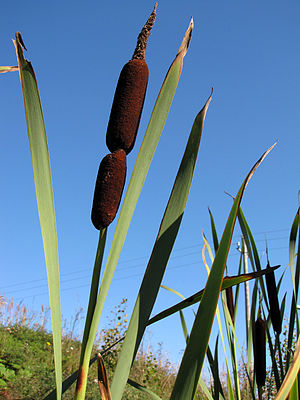Difference between revisions of "Category:Typhaceae"
(move from main namespace) |
m (rm broken IPA) |
||
| Line 12: | Line 12: | ||
}} | }} | ||
| − | The '''Typhaceae''' | + | The '''Typhaceae''' are a [[family (biology)|family]] of [[flowering plants]]. The [[botanical name]] for the family has been recognized by most taxonomists. |
The [[APG II system]], of 2003 (unchanged from the [[APG system]], 1998), also recognizes this family, and assigns it to the order [[Poales]] in the clade [[commelinids]], in the [[Monocotyledon|monocots]]. The family then consisted of [[Monotype (biology)|one genus]] (''[[Typha]]''), totalling a dozen species of [[perennial plant]]s of wet habitats. More recently, the [[APG III system]] of 2009 included a second genus, ''[[Sparganium]]'', in this family. The two genera together have a total of 51 known species.<ref name="Christenhusz-Byng2016">{{cite journal |author1=Christenhusz, M. J. M. |author2=Byng, J. W. |lastauthoramp=yes | year = 2016 | title = The number of known plants species in the world and its annual increase | journal = Phytotaxa | volume = 261 | pages = 201–217 | url = http://biotaxa.org/Phytotaxa/article/download/phytotaxa.261.3.1/20598 | doi = 10.11646/phytotaxa.261.3.1 | issue = 3 | publisher = Magnolia Press }}</ref> | The [[APG II system]], of 2003 (unchanged from the [[APG system]], 1998), also recognizes this family, and assigns it to the order [[Poales]] in the clade [[commelinids]], in the [[Monocotyledon|monocots]]. The family then consisted of [[Monotype (biology)|one genus]] (''[[Typha]]''), totalling a dozen species of [[perennial plant]]s of wet habitats. More recently, the [[APG III system]] of 2009 included a second genus, ''[[Sparganium]]'', in this family. The two genera together have a total of 51 known species.<ref name="Christenhusz-Byng2016">{{cite journal |author1=Christenhusz, M. J. M. |author2=Byng, J. W. |lastauthoramp=yes | year = 2016 | title = The number of known plants species in the world and its annual increase | journal = Phytotaxa | volume = 261 | pages = 201–217 | url = http://biotaxa.org/Phytotaxa/article/download/phytotaxa.261.3.1/20598 | doi = 10.11646/phytotaxa.261.3.1 | issue = 3 | publisher = Magnolia Press }}</ref> | ||
Latest revision as of 18:23, 20 August 2018
| Typhaceae | |
|---|---|

| |
| Typha latifolia | |
| Scientific classification | |
| Kingdom: | Plantae |
| Clade: | Angiosperms |
| Clade: | Monocots |
| Clade: | Commelinids |
| Order: | Poales |
| Family: | Typhaceae Juss.[1] |
| Genera | |
The Typhaceae are a family of flowering plants. The botanical name for the family has been recognized by most taxonomists.
The APG II system, of 2003 (unchanged from the APG system, 1998), also recognizes this family, and assigns it to the order Poales in the clade commelinids, in the monocots. The family then consisted of one genus (Typha), totalling a dozen species of perennial plants of wet habitats. More recently, the APG III system of 2009 included a second genus, Sparganium, in this family. The two genera together have a total of 51 known species.[2]
The Cronquist system, of 1981, also recognized such a family and placed it in the order Typhales, in the subclass Commelinidae in class Liliopsida in division Magnoliophyta.
The Wettstein system, last updated in 1935, placed the family in order Pandanales.
Members can be recognized as large marsh herbs with two-ranked leaves and a brownish compact spike of unisexual flowers.
The earliest fossils, including pollen and flowers, have been recovered from late Cretaceous deposits.[3]
References
- ↑ Stevens, P. F. "ANGIOSPERM PHYLOGENY WEBSITE, version 12". Typhaceae. Missouri Botanical Garden. Retrieved 9 July 2013.
- ↑ Christenhusz, M. J. M. & Byng, J. W. (2016). "The number of known plants species in the world and its annual increase". Phytotaxa. Magnolia Press. 261 (3): 201–217. doi:10.11646/phytotaxa.261.3.1.
- ↑ Bremer, K. (2002). "Gondwanan Evolution of the Grass Alliance of Families (Poales)." Evolution, 56(7): 1374-1387. [1]
External links
- Typhaceae in L. Watson and M.J. Dallwitz (1992 onwards). The families of flowering plants: descriptions, illustrations, identification, information retrieval. Version: 27 April 2006. http://delta-intkey.com
- links at CSDL
Acknowledgements
This article uses material from the Wikipedia article Typhaceae, which is released under the Creative Commons Attribution-Share-Alike License 3.0.
Pages in category "Typhaceae"
The following 4 pages are in this category, out of 4 total.